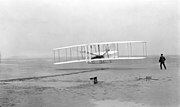The Wright Brothers
Following Lilienthal's principles of jumping before flying, the brothers built and tested a series of kite and glider designs from 1900 to 1902 before attempting to build a powered design. The gliders worked, but not as well as the Wrights had expected based on the experiments and writings of their 19th century predecessors. Their first glider, launched in 1900, had only about half the lift they anticipated. Their second glider, built the following year, performed even more poorly. Rather than giving up, the Wrights constructed their own wind tunnel and created a number of sophisticated devices to measure lift and drag on the 200 wing designs they tested. As a result, the Wrights corrected earlier mistakes in calculations regarding drag and lift, though they missed the effect of Reynolds number (known since 1883), which would have given them an even bigger advantage. Their testing and calculating produced a third glider design, which they flew in 1902. It performed far better than the previous models. In the end, by establishing their rigorous system of designing, wind-tunnel testing of models and flight testing of full-size prototypes, the Wrights not only built a working aircraft but also helped advance the modern science of aeronautical engineering.
 The Wrights appear to be the first design team to make serious studied attempts to simultaneously solve the power and control problems. Both problems proved difficult, but they never lost interest. Eventually, they designed and built an engine that could provide the needed power, and solved the control problem through a system known as "wing warping". Although this method was used only briefly during the history of aviation, it worked at the low airspeeds their designs would fly at, and proved to be a key advance, leading directly to modern ailerons. While many aviation pioneers appeared to leave safety largely to chance, the Wrights' design was greatly influenced by the need to teach themselves to fly without unreasonable risk to life and limb, by surviving crashes. This, not lack of power, was the reason for the low speed and for taking off in a head wind. It was also the reason for the rear-heavy design, for the canard, and for the anhedral wings.
The Wrights appear to be the first design team to make serious studied attempts to simultaneously solve the power and control problems. Both problems proved difficult, but they never lost interest. Eventually, they designed and built an engine that could provide the needed power, and solved the control problem through a system known as "wing warping". Although this method was used only briefly during the history of aviation, it worked at the low airspeeds their designs would fly at, and proved to be a key advance, leading directly to modern ailerons. While many aviation pioneers appeared to leave safety largely to chance, the Wrights' design was greatly influenced by the need to teach themselves to fly without unreasonable risk to life and limb, by surviving crashes. This, not lack of power, was the reason for the low speed and for taking off in a head wind. It was also the reason for the rear-heavy design, for the canard, and for the anhedral wings.The Wrights made the first sustained, controlled and powered heavier-than-air flight at Kill Devil Hills, North Carolina, a town five miles down the road from Kitty Hawk, North Carolina on December 17, 1903
The first flight by Orville Wright, of 121 feet (37 m) in 12 seconds, was recorded in a famous photograph. In the fourth flight of the same day, Wilbur Wright flew 852 feet (260 m) in 59 seconds. The flights were witnessed by 4 lifesavers and a boy from the village, making them the first public flights and certainly the first well-documented ones.
The telegram station the Wright Brothers used to send their message of successful, sustained, powered flight is now a restaurant named "The Black Pelican."
ไม่มีความคิดเห็น:
แสดงความคิดเห็น